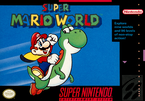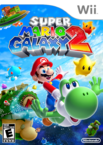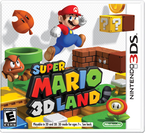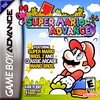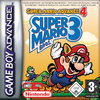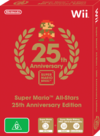Super Mario (series): Difference between revisions
| Line 17: | Line 17: | ||
==Main games== | ==Main games== | ||
{{rewrite-expand}} | {{rewrite-expand}} | ||
===''Super Mario Bros. | {| align=center width=100% border=1 | ||
[[File:SMB Boxart.PNG| | |- style="background-color: whitesmoke;" | ||
!width=15%|Title, original release and system | |||
!width=85%|Synopsis and Ratings | |||
|- | |||
!''Super Mario Bros. | |||
---- | |||
[[File:SMB Boxart.PNG|145x145px]] | |||
[ | |''[[Super Mario Bros.]]'' is the first installment in the ''Super Mario'' series. It was first released for the Famicom and the NES in 1985. This game set the standard for the later games, and it was released for many new systems, including the [[Game Boy Advance]] and the [[Virtual Console]] for the Wii. This game marks the first appearance for many new protagonists, species, and villains. These characters include Bowser, Princess Peach (then known as Princess Toadstool), [[Goomba]]s, [[Koopa Troopa]]s, and many more. This game also produced many sequels. | ||
|- style=font-size:8pt align=center | |||
|{{releasedate|Japan|1985}} [[NES]] | |||
A year after the release of ''Super Mario Bros.'', [[Nintendo]] released ''[[Super Mario Bros.: The Lost Levels]]''. It was released for the [[Famicom Disk System]]. It uses a slightly altered version of ''Super Mario Bros.'''s engine, with different levels and new features including altered graphics and new enemy behavior. Nintendo of America originally deemed this game too challenging and too much like the original to sell well in western countries. Recently, this game was released for the Virtual Console on the Wii. | |(Ratings unavailible) | ||
|- | |||
!''Super Mario Bros.: The Lost Levels | |||
---- | |||
[[File:SMB2 Boxart.PNG| | [[File:SMB TLL Boxart.PNG|145x145px]] | ||
|A year after the release of ''Super Mario Bros.'', [[Nintendo]] released ''[[Super Mario Bros.: The Lost Levels]]''. It was released for the [[Famicom Disk System]]. It uses a slightly altered version of ''Super Mario Bros.'''s engine, with different levels and new features including altered graphics and new enemy behavior. Nintendo of America originally deemed this game too challenging and too much like the original to sell well in western countries. Recently, this game was released for the Virtual Console on the Wii. | |||
|- style=font-size:8pt align=center | |||
|{{releasedate|Japan|1986}} [[Famicom]] | |||
'' | |(Ratings unavailible) | ||
|- | |||
!''Super Mario Bros. 2 | |||
---- | |||
[[File:SMB2 Boxart.PNG|145x145px]] | |||
|''[[Super Mario Bros. 2]]'' is the third game in the ''Super Mario'' series. It was released in 1988 for the Famicon and the NES. New species first appear in this game, including [[Albatoss]] and [[Shy Guy|Shy Guys]], and it introduces [[Wart]] and [[Birdo]]. ''Super Mario Bros. 2'' is also the first game to feature four distinctly playable characters (Mario, Luigi, [[Toad]], and [[Princess Peach]]). ''Super Mario Bros. 2'' was based on the Japanese game ''[[Yume Kōjō: Doki Doki Panic]]''. This is also the only game in the series that Princess Peach was not kidnapped in. | |||
|- style=font-size:8pt align=center | |||
|{{releasedate|USA|1988}} [[NES]] | |||
|(Ratings unavailible) | |||
|- | |||
!''Super Mario Bros. 3 | |||
---- | |||
[[File:SMB3 Boxart.PNG|145x145px]] | |||
|''[[Super Mario Bros. 3]]'' is the fourth ''Super Mario Bros.'' game. It was released for the Famicon and the NES. A remake was later made for the ''[[Super Mario Advance (series)|Super Mario Advance]]'' series. It is called ''Super Mario Advance 4: Super Mario Bros. 3''. New species appear, like [[Boo]] and [[Spike (enemy)|Spike]]. [[Boom Boom]] and the [[Koopalings]] also first appear. New power-ups also appear such as the [[Super Leaf]], the [[Hammer Suit]] and the [[Frog Suit]]. It has been considered as one of the greatest games of all time. Its complexity and challenging levels made it a huge success. In addition to new power ups, it featured new moves, items, and enemies. It also features special non-level parts of each world, including Toad Houses where lives are earned and Spade Panels, as well as some secret parts, such as the White Toad House and the Treasure Ship. | |||
|- style=font-size:8pt align=center | |||
|{{releasedate|Japan|1988}} [[NES]] | |||
|(Ratings unavailible) | |||
|- | |||
!''Super Mario World | |||
---- | |||
[[ | [[File:Super Mario World Box.png|145x145px]] | ||
|''[[Super Mario World]]'' also known as '''''Super Mario Bros. 4: Super Mario World''''' was released in 1990 for the [[Super Nintendo Entertainment System|Super Famicom]]. It was also re-released as the second installment in the ''Super Mario Advance'' series. In this game Mario and Peach go on a trip to [[Dinosaur Land]] but things go awry when Bowser kidnaps Peach. This game was notable for inroducing [[Yoshi]] and his [[Yoshi (species)|species]]. It is the fifth installment in the ''Super Mario'' series. | |||
|- style=font-size:8pt align=center | |||
: | |{{releasedate|Japan|1990}} [[SNES]] | ||
''[ | |(Ratings unavailible) | ||
|- | |||
!''Super Mario 64 | |||
---- | |||
[[File:260px-Super Mario 64 box cover.jpg|145x145px]] | |||
|''[[Super Mario 64]]'' has its own unique gameplay and story to the ''Super Mario'' series. It was released in 1996 for the [[Nintendo 64]]. In this game, [[Mario]] uses [[Power Star]]s to retrieve the kidnapped [[Princess Peach|Peach]]. Mario jumps into paintings trying to find Peach. This is also the first 3D game in this series. Though it was not the first 3-D platforming game, it revolutionized the genre, with many games soon following its formula, using it as a sort of benchmark. It is widely acclaimed as one of the greatest games of all time. A remake for this game came out in 2004 for the [[Nintendo DS]]. It is simply called, ''[[Super Mario 64 DS]]''. This game introduced new bosses, such as [[King Bob-omb]] and [[Eyerok]]. | |||
|- style=font-size:8pt align=center | |||
|{{releasedate|Japan|1996}} [[Nintendo 64]] | |||
'' | |[http://ign64.ign.com/objects/000/000606.html IGN - '''9.8: Amazing''']• [http://www.gamespot.com/n64/action/supermario64/index.html?tag=result;title;1 Gamespot - '''9.4: Superb'''] | ||
|- | |||
!''Super Mario Sunshine | |||
---- | |||
[[File:200px-Super mario sunshine.jpg|145x145px]] | |||
|''[[Super Mario Sunshine]]'' was released in 2002 for the [[Nintendo GameCube]]. Its gameplay is similar to ''Super Mario 64''. Instead of collecting Power Stars, the player collects [[Shine Sprite]]s. This game also introduced many recurring characters and bosses in the Mario series, including [[Toadsworth]], [[Bowser Jr.]], [[Petey Piranha]], [[Gooper Blooper]], [[Piantas]], [[Nokis]], [[Shadow Mario]], and [[F.L.U.D.D.]]. ''Super Mario Galaxy'' is the respective follow-up to this game. This is the second 3D game in the series. | |||
|- style=font-size:8pt align=center | |||
|{{releasedate|Japan|2002}} [[Nintendo Gamecube]] | |||
|[http://cube.ign.com/objects/016/016713.html IGN - '''9.4: Outstanding'''] • [http://www.gamespot.com/gamecube/action/supermariosunshine/index.html?tag=result;title;0 Gamespot - '''8.0: Great'''] | |||
|- | |||
!''New Super Mario Bros. | |||
---- | |||
[[File:NewSuperMarioBrothers.jpg|145x145px]] | |||
|''[[New Super Mario Bros.]]'' is the eighth installment in the ''Super Mario'' series. It starts out when Bowser Jr. kidnaps Peach during a strange accident. Luigi is playable in this game, too. Luigi was not playable since ''Super Mario Bros. 3''. The game features a solo story mode with Mario or Luigi, a two-player wireless game Mario vs. Luigi, as well as a mini-game mode for up to four players. It was released in 2006 for the [[Nintendo DS]]. It spiraled a sequel, ''New Super Mario Bros. Wii''. | |||
|- style=font-size:8pt align=center | |||
|{{releasedate|USA|2006}} [[Nintendo DS]] | |||
'' | |[http://ds.ign.com/objects/682/682879.html IGN - '''9.5: Incredible'''] • [http://www.gamespot.com/ds/action/supermariobrosds/index.html?tag=result;title;0 Gamespot - '''9.0: Superb] | ||
|- | |||
!''Super Mario Galaxy | |||
---- | |||
[[File:NSMBWAUBoxart.jpg| | [[File:SmG.jpg|145x145px]] | ||
|''[[Super Mario Galaxy]]'' is the ninth installment in the ''Super Mario'' series and the third 3D game in the series. However, unlike the previous two 3D installments for the Mario series, this game takes place in deep space. Most of the game's levels consist of many small planets and planetoids, while others have bigger planets. A new popular species and character. appear, [[Luma (species)|Luma]] and [[Rosalina]]. It was released in 2007 for the [[Wii]]. This game spiraled a sequel, simply called ''Super Mario Galaxy 2''. | |||
|- style=font-size:8pt align=center | |||
|{{releasedate|Japan|2007}} [[Nintendo Wii]] | |||
|[http://wii.ign.com/objects/748/748588.html IGN - '''9.7: Outstanding'''] • [http://www.gamespot.com/wii/action/supermario128/index.html?tag=result;title;0 Gamespot - '''9.5: Superb'''] | |||
|- | |||
!''New Super Mario Bros. Wii | |||
---- | |||
[[ | [[File:NSMBWAUBoxart.jpg|145x145px]] | ||
|''[[New Super Mario Bros. Wii]]'' is the tenth installment in the ''Super Mario'' series and the second for the Wii. It is a follow-up to ''New Super Mario Bros.''. In this game, [[Yoshi (species)|Yoshi]]s are rideable and the Koopalings return. In addition to the single-player experience, the game also features a multiplayer mode for up to four players. Two new playable characters appear, [[Yellow Toad (New Super Mario Bros. Wii)|Yellow Toad]] and [[Blue Toad (New Super Mario Bros. Wii)|Blue Toad]]. New power-ups also appear including the [[Propeller Suit]] and the [[Penguin Suit]]. | |||
|- style=font-size:8pt align=center | |||
|{{releasedate|Australia|2009}} [[Nintendo Wii]] | |||
Released in 2010 for the Wii, ''[[Super Mario Galaxy 2]]'' is the eleventh installment in the ''Super Mario'' series. It is also the fourth 3D game in the series. The sequel contains many elements from its predecessor, such as the adventure being in outer space, recurring objects such as Launch Stars, recurring items including the Bee Mushroom, and the elements of gravity. However, the game introduces new elements such as the utilization of Yoshi, new power-ups such as the Cloud Flower. Rosalina reappears and new characters of the [[Luma (species)|Luma]] species appear including [[Lubba]]. This is the third installment for the Wii in the ''Super Mario'' series. | |[http://wii.ign.com/objects/143/14354229.html IGN - '''8.9: Great'''] • [http://www.gamespot.com/wii/action/newsupermariobroswii/index.html?tag=result;title;0 Gamespot - '''8.5: Great'''] | ||
|- | |||
!''Super Mario Galaxy 2 | |||
---- | |||
[[ | [[File:Smg2boxart.png|145x145px]] | ||
|Released in 2010 for the Wii, ''[[Super Mario Galaxy 2]]'' is the eleventh installment in the ''Super Mario'' series. It is also the fourth 3D game in the series. The sequel contains many elements from its predecessor, such as the adventure being in outer space, recurring objects such as Launch Stars, recurring items including the Bee Mushroom, and the elements of gravity. However, the game introduces new elements such as the utilization of Yoshi, new power-ups such as the Cloud Flower. Rosalina reappears and new characters of the [[Luma (species)|Luma]] species appear including [[Lubba]]. This is the third installment for the Wii in the ''Super Mario'' series. | |||
|- style=font-size:8pt align=center | |||
|{{releasedate|USA|2010}} [[Wii]] | |||
|[http://wii.ign.com/objects/143/14354736.html IGN - '''10.0: Masterful'''] • [http://www.gamespot.com/wii/action/supermariogalaxy2/index.html?tag=result;title;0 Gamespot - '''10.0: Prime'''] | |||
Making its first debut for the [[Nintendo 3DS]], ''[[Super Mario 3D Land]]'' is the fifth 3D game in the series, and the twelfth game overall. The levels of ''Super Mario 3D Land'' are much more linear and compact than the other 3D titles, more along the lines of the side-scrolling games. Many retro power-ups and characters returns, such as | |- | ||
!''Super Mario 3D Land'' | |||
---- | |||
[[File:SM3DL UScover.png|145x145px]] | |||
|Making its first debut for the [[Nintendo 3DS]], ''[[Super Mario 3D Land]]'' is the fifth 3D game in the series, and the twelfth game overall. The levels of ''Super Mario 3D Land'' are much more linear and compact than the other 3D titles, more along the lines of the side-scrolling games. Many retro power-ups and characters returns, such as [[False Bowser]]s, the [[Super Leaf]] and [[Boom Boom]]. New power-ups are also introduced, such as [[Boomerang Mario]], and [[White Tanooki Mario]]. It also introduces new enemies and a partner of Boom Boom named [[Pom Pom]]. | |||
|- style=font-size:8pt align=center | |||
|{{releasedate|Japan|2011}} [[Nintendo 3DS]] | |||
|[http://ds.ign.com/objects/099/099437.html IGN - '''9.5: Amazing'''] • [http://www.gamespot.com/super-mario-3d-land?section=&subsec=title Gamespot - '''8.0: Good'''] | |||
|- | |||
|} | |||
==Ports and Remakes== | ==Ports and Remakes== | ||
Revision as of 21:46, April 1, 2012
Template:Articleabout Template:Series-infobox
The Super Mario series, also called the main series or main games, is the biggest sub-series of the Mario series. It started in 1985 with the creation of Super Mario Bros. on the Famicom and subsequently the Nintendo Entertainment System. It has been followed by many sequels released in almost every Nintendo video game console to date, except the Game Boy, the Game Boy Color and the Game Boy Advance.
These games, but one, follow the traditional story about Mario and, usually, his brother Luigi, in their long quest to search and rescue Princess Peach from the clutches of Bowser, who is causing mischief and wants conquer the Mushroom Kingdom, or any other place, depending the game. The Mario Bros. adventure is not easy as they must face Bowser's troops all long the way, who have orders by the King Koopa himself, to stop the brave brothers.
All the games, and even some remakes, have been developed exclusively by the Nintendo Entertainment Analysis and Development branch but not by the same sub-division. While there is no Mario platform game in development or confirmed for Wii U, director Yoshiaki Koizumi has stated he has a lot of new ideas for a Wii U Mario platform game.Template:Refneeded
Main games
It has been requested that this article be rewritten and expanded to include more information.
| Title, original release and system | Synopsis and Ratings |
|---|---|
| Super Mario Bros.
|
Super Mario Bros. is the first installment in the Super Mario series. It was first released for the Famicom and the NES in 1985. This game set the standard for the later games, and it was released for many new systems, including the Game Boy Advance and the Virtual Console for the Wii. This game marks the first appearance for many new protagonists, species, and villains. These characters include Bowser, Princess Peach (then known as Princess Toadstool), Goombas, Koopa Troopas, and many more. This game also produced many sequels. |
| Template:Releasedate NES | (Ratings unavailible) |
| Super Mario Bros.: The Lost Levels
|
A year after the release of Super Mario Bros., Nintendo released Super Mario Bros.: The Lost Levels. It was released for the Famicom Disk System. It uses a slightly altered version of Super Mario Bros.'s engine, with different levels and new features including altered graphics and new enemy behavior. Nintendo of America originally deemed this game too challenging and too much like the original to sell well in western countries. Recently, this game was released for the Virtual Console on the Wii. |
| Template:Releasedate Famicom | (Ratings unavailible) |
| Super Mario Bros. 2
|
Super Mario Bros. 2 is the third game in the Super Mario series. It was released in 1988 for the Famicon and the NES. New species first appear in this game, including Albatoss and Shy Guys, and it introduces Wart and Birdo. Super Mario Bros. 2 is also the first game to feature four distinctly playable characters (Mario, Luigi, Toad, and Princess Peach). Super Mario Bros. 2 was based on the Japanese game Yume Kōjō: Doki Doki Panic. This is also the only game in the series that Princess Peach was not kidnapped in. |
| Template:Releasedate NES | (Ratings unavailible) |
| Super Mario Bros. 3
|
Super Mario Bros. 3 is the fourth Super Mario Bros. game. It was released for the Famicon and the NES. A remake was later made for the Super Mario Advance series. It is called Super Mario Advance 4: Super Mario Bros. 3. New species appear, like Boo and Spike. Boom Boom and the Koopalings also first appear. New power-ups also appear such as the Super Leaf, the Hammer Suit and the Frog Suit. It has been considered as one of the greatest games of all time. Its complexity and challenging levels made it a huge success. In addition to new power ups, it featured new moves, items, and enemies. It also features special non-level parts of each world, including Toad Houses where lives are earned and Spade Panels, as well as some secret parts, such as the White Toad House and the Treasure Ship. |
| Template:Releasedate NES | (Ratings unavailible) |
| Super Mario World
|
Super Mario World also known as Super Mario Bros. 4: Super Mario World was released in 1990 for the Super Famicom. It was also re-released as the second installment in the Super Mario Advance series. In this game Mario and Peach go on a trip to Dinosaur Land but things go awry when Bowser kidnaps Peach. This game was notable for inroducing Yoshi and his species. It is the fifth installment in the Super Mario series. |
| Template:Releasedate SNES | (Ratings unavailible) |
| Super Mario 64
|
Super Mario 64 has its own unique gameplay and story to the Super Mario series. It was released in 1996 for the Nintendo 64. In this game, Mario uses Power Stars to retrieve the kidnapped Peach. Mario jumps into paintings trying to find Peach. This is also the first 3D game in this series. Though it was not the first 3-D platforming game, it revolutionized the genre, with many games soon following its formula, using it as a sort of benchmark. It is widely acclaimed as one of the greatest games of all time. A remake for this game came out in 2004 for the Nintendo DS. It is simply called, Super Mario 64 DS. This game introduced new bosses, such as King Bob-omb and Eyerok. |
| Template:Releasedate Nintendo 64 | IGN - 9.8: Amazing• Gamespot - 9.4: Superb |
| Super Mario Sunshine
|
Super Mario Sunshine was released in 2002 for the Nintendo GameCube. Its gameplay is similar to Super Mario 64. Instead of collecting Power Stars, the player collects Shine Sprites. This game also introduced many recurring characters and bosses in the Mario series, including Toadsworth, Bowser Jr., Petey Piranha, Gooper Blooper, Piantas, Nokis, Shadow Mario, and F.L.U.D.D.. Super Mario Galaxy is the respective follow-up to this game. This is the second 3D game in the series. |
| Template:Releasedate Nintendo Gamecube | IGN - 9.4: Outstanding • Gamespot - 8.0: Great |
| New Super Mario Bros.
|
New Super Mario Bros. is the eighth installment in the Super Mario series. It starts out when Bowser Jr. kidnaps Peach during a strange accident. Luigi is playable in this game, too. Luigi was not playable since Super Mario Bros. 3. The game features a solo story mode with Mario or Luigi, a two-player wireless game Mario vs. Luigi, as well as a mini-game mode for up to four players. It was released in 2006 for the Nintendo DS. It spiraled a sequel, New Super Mario Bros. Wii. |
| Template:Releasedate Nintendo DS | IGN - 9.5: Incredible • Gamespot - 9.0: Superb |
| Super Mario Galaxy
|
Super Mario Galaxy is the ninth installment in the Super Mario series and the third 3D game in the series. However, unlike the previous two 3D installments for the Mario series, this game takes place in deep space. Most of the game's levels consist of many small planets and planetoids, while others have bigger planets. A new popular species and character. appear, Luma and Rosalina. It was released in 2007 for the Wii. This game spiraled a sequel, simply called Super Mario Galaxy 2. |
| Template:Releasedate Nintendo Wii | IGN - 9.7: Outstanding • Gamespot - 9.5: Superb |
| New Super Mario Bros. Wii
|
New Super Mario Bros. Wii is the tenth installment in the Super Mario series and the second for the Wii. It is a follow-up to New Super Mario Bros.. In this game, Yoshis are rideable and the Koopalings return. In addition to the single-player experience, the game also features a multiplayer mode for up to four players. Two new playable characters appear, Yellow Toad and Blue Toad. New power-ups also appear including the Propeller Suit and the Penguin Suit. |
| Template:Releasedate Nintendo Wii | IGN - 8.9: Great • Gamespot - 8.5: Great |
| Super Mario Galaxy 2
|
Released in 2010 for the Wii, Super Mario Galaxy 2 is the eleventh installment in the Super Mario series. It is also the fourth 3D game in the series. The sequel contains many elements from its predecessor, such as the adventure being in outer space, recurring objects such as Launch Stars, recurring items including the Bee Mushroom, and the elements of gravity. However, the game introduces new elements such as the utilization of Yoshi, new power-ups such as the Cloud Flower. Rosalina reappears and new characters of the Luma species appear including Lubba. This is the third installment for the Wii in the Super Mario series. |
| Template:Releasedate Wii | IGN - 10.0: Masterful • Gamespot - 10.0: Prime |
| Super Mario 3D Land
|
Making its first debut for the Nintendo 3DS, Super Mario 3D Land is the fifth 3D game in the series, and the twelfth game overall. The levels of Super Mario 3D Land are much more linear and compact than the other 3D titles, more along the lines of the side-scrolling games. Many retro power-ups and characters returns, such as False Bowsers, the Super Leaf and Boom Boom. New power-ups are also introduced, such as Boomerang Mario, and White Tanooki Mario. It also introduces new enemies and a partner of Boom Boom named Pom Pom. |
| Template:Releasedate Nintendo 3DS | IGN - 9.5: Amazing • Gamespot - 8.0: Good |
Ports and Remakes
Super Mario Bros. (Game & Watch)
- Year Released – 1986
- System – Game & Watch
In 1986, Super Mario Bros. was remade into a simplified version for the Game & Watch, it was moving side-scroller where Mario have to move over several platforms avoiding Lakitus and some Bullet Bills.
Super Mario All-Stars
- Year Released – 1993
- System – Super Famicom, Super Nintendo Entertainment System
Super Mario All-Stars also known as Super Mario Collection in Japan was released in 1993 also for the Super Nintendo Entertainment System. It is a remake of the first four Super Mario series games. Super Mario Bros., Super Mario Bros. 2 Super Mario Bros. 3, and Super Mario Bros.: The Lost Levels. This game updated the four games graphics and music to make it better. However, it is not technically considered an installment because it is just a simple remake.
Super Mario All-Stars + Super Mario World
- Year Released – 1994
- System – Super Nintendo Entertainment System
Super Mario All-Stars + Super Mario World is an America/Europe-only remake of Super Mario All-Stars that now includes Super Mario World for the Super Nintendo Entertainment System. it is the second remake of the series.
Super Mario Bros. Deluxe
- Year Released – 1999
- System – Game Boy Color
Super Mario Bros. Deluxe is a Game Boy Color remake which includes the first two Super Mario games ever released: Super Mario Bros. and Super Mario Bros.: The Lost Levels (that last under the name of Super Mario Bros.: For Super Players). Besides those games, it also featured many other collectibles, including images that could be printed with the Game Boy Printer, Cable Link interface multi-player, records sharing by infrared connection, a calendar, a fortune teller, etc. Unlike other remakes, it wasn't developed by Nintendo EAD, but by Nintendo R&D2.
Super Mario Advance
- Year Released – 2001
- System – Game Boy Advance
Super Mario Advance is a remake of Super Mario Bros. 2 made for the handheld game system Game Boy Advance, and released in 2001. Like the Super Mario All-Stars port, Super Mario Advance had updated graphics.
Super Mario World: Super Mario Advance 2
- Year Released – 2001
- System – Game Boy Advance
Super Mario World: Super Mario Advance 2 is a remake of Super Mario World made for the Game Boy Advance. It was the second title in the Super Mario Advance series and was released in 2002. There are various differences between the original Super Mario World and Super Mario Advance 2. The game was a gigantic hit for Nintendo and the Game Boy Advance, selling 3,290,000 copies in the United States and 5,460,000 copies worldwide. Additionally, Luigi's sprite has been changed and made taller than Mario to match his normal appearance, and the Mario Bros. classic game has been included in the game (like the other Mario Advance games), with multiplayer playable.
Super Mario Advance 4: Super Mario Bros. 3
- Year Released – 2003
- System – Game Boy Advance
In 2003, the fourth entry in the Super Mario Advance series, Super Mario Advance 4: Super Mario Bros. 3, was released for the Game Boy Advance. It boasted similar graphics and sound to the Super Mario All-Stars version, and made use of the e-Reader. A few e-cards came included with new copies of the game, while two sets (referred to as "series") of cards, were released and sold alongside the game. By scanning special cards into the e-Reader, players were able to upload items, videos, and most importantly, new levels into game. One notable item was the Cape Feather from Super Mario World, which allowed Mario to transform in Cape Mario. There were also two Switch cards that the player could activate (and deactivate) the effects of by scanning them; the Orange Switch and the Blue Green Switch. Scanning these switches triggered small functions in the game. The e-Reader feature is still available in the European version, but it is disabled by default and unable to access.
Classic NES Series: Super Mario Bros.
- Year Released – 2004
- System – Game Boy Advance
The original NES version of Super Mario Bros. was released for the Game Boy Advance as part of the Classic NES series of games in commemoration for the 20th anniversary of the release of the original Famicom ad NES. It is a port, and didn't feature any new addition, all of the bugs were left in the game and only the graphics were down-scaled to fit the GBA screen resolution.
Famicom Mini: Super Mario Bros. 2
- Year Released – 2005
- System – Game Boy Advance
In Japan, the Classic NES Series were known as Famicom Mini. The original Super Mario Bros. 2 (known is western regions as Super Mario Bros.: The Lost Levels) was released only in Japan. Much like Super Mario Bros., it didn't feature something new additon, bugs were left untouched and the graphics were down-scaled too.
Super Mario 64 DS
- Year Released – 2004
- System – Nintendo DS
- For this game's beta elements, see here.
Super Mario 64 DS is the remake of Super Mario 64. It was released in 2004 for the Nintendo DS. It is also the first Mario game released for the Nintendo DS. Though it is a remake, there are many differences. One difference is that there are many additional secret stars, making 150 Power Stars instead of the previous 120. Wario, Luigi, and Yoshi are also playable. There is also mini-games.
Super Mario All-Stars - 25th Anniversary Edition
- Year Released – 2010
- System – Wii
For the Wii in 2010, Super Mario All-Stars - 25th Anniversary Edition celebrates the 25th anniversary of Mario with the same games as mention in the All-Stars section. It is a port of the original game Super Mario All-Stars.
